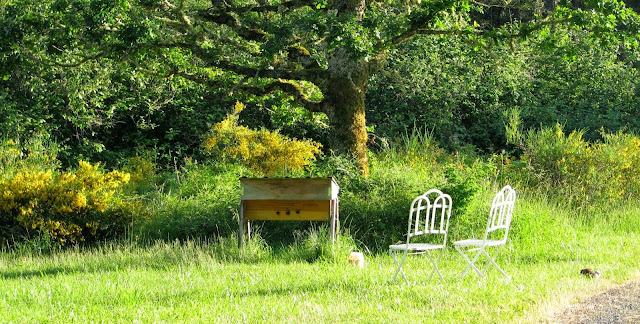Back when I was first learning to cook, I had no patience for fry pans that would let my food stick. I was all over that Non-stick coating. I thought it was the best thing ever! I gave away all the Revere Ware fry pans I'd received as wedding gifts and bought myself a fine set of Teflon pans.
One year later I replaced them because the coating had bubbled off. And the next, and the next...
Then it occurred to me - where was that flaking non-stick coating disappearing to? That was when I started paying attention to what was going into my families stomachs besides food. Plastics were providing lots of BPA, our apples contained 28 kinds of chemicals and the USDA had proclaimed that Ketchup could be counted as a vegetable in school lunches!
Fast forward and you will find me cooking like my grandma.
Most of our food is grown by us or Organic farmers near us and I am now happily cooking our food in Cast Iron, not Teflon.
Le Creuset is nice if you can afford it. I find a nice pan once in a
while at the thrift store. Lodge cast iron is much more affordable but does not hold up
over the years like Le Creuset.
Ultimately I prefer non-porcelain-enamel coated,
antique cast iron. The only drawback of non-porcelain-enamel cast iron is that if
you cook something acid, like tomato sauce, you have to re-season the
pan. The tomato sauce will pull off the patina of oil and take up a little of the iron.
Elder women in my life have used this fact to their advantage and used it to add iron
to their blood. A natural and convenient cure for mild anemia!
This winter I decided to cook up a batch of my
Wood-stove Naan.
While I was doing this I realized it had been some time since I had re-seasoned a few of our cast iron pans. Putting them in a bed of coals for an hour or so burns all that greasy buildup off so that you can start over with a nice smooth pan.
Notice I say "good cast iron" because there is a big difference in cast iron quality.
This is why I prefer antique pans. It is very hard to find a well made modern cast iron pan. Most modern pans are made in China, very cheaply and with low standards.
I find that Griswold pans have a certain cache in the antique world
for a reason, they are very high quality pans. The one on the right is a
Griswold. These two have been in storage for the same amount of time
and yet the Taiwan dutch oven is much rustier. It is also much rougher
and poorly designed in the lid and handle. I didn't bother re-seasoning
it this year. It's headed back to the thrift store I think.
A cast iron pan must be very smooth inside to be even close to non-stick.
You can't have great big pits and dimply surfaces.
You also don't want sharp mold seams anywhere near your sink or stove. They can, and will, chip the heck out of them. And if they are very raised they can cut your fingers too.
The quality of the actual iron is also substandard on the newer cast iron and, to be honest, I just don't trust that there isn't something like Lead or worse in the cast iron from China or another importing country.
Once my pans had the old grease burned off I scrubbed them with a some steel wool and dried them by heating them on the burner.
Then I rubbed them down with bacon grease (olive oil is good too) and popped them in the oven at 325 degrees for an hour or so.
Tada! Good as new.
As Julia Child and my Grandma suggested, a bit of back fat or the rind
from a bacon, rubbed on the surface of a good cast iron fry pan will
make it very nearly non-stick. You don't have to pour in the oil to keep
things from sticking in good cast iron. It is a joy to cook with, easy to
clean (just rinse in warm water, no soap, heat on the stove top to dry,
wipe with oil and it is ready for tomorrow) and presents no toxic
outcome to my health.
I've learned my lesson about what I do and don't want to eat from my cooking pans!






















